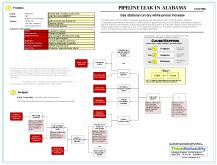 On September 9, 2016, a leak in a gasoline pipeline was discovered south of Birmingham, Alabama. Investigators estimate that as much as 8,000 barrels of gasoline spilled. Luckily, the environmental impact of the spill seems to be relatively limited because the spilled gasoline pooled into nearby mining retention pools. Measurements of local waterways show no indication of gasoline. The other impacts of the spill, both to customers and the company, have, however, been significant.
On September 9, 2016, a leak in a gasoline pipeline was discovered south of Birmingham, Alabama. Investigators estimate that as much as 8,000 barrels of gasoline spilled. Luckily, the environmental impact of the spill seems to be relatively limited because the spilled gasoline pooled into nearby mining retention pools. Measurements of local waterways show no indication of gasoline. The other impacts of the spill, both to customers and the company, have, however, been significant.
The pipeline in question typically provides nearly 40 percent of the Southeast and East Coast regions’ gasoline. Following the discovery of the leak, it was partially closed while a bypass was installed that allowed product to flow around the length of pipeline that was leaking. The pipeline was put back in service on the evening of September 21. Gasoline shipments to the region were delayed while the pipeline was out of service and some gas stations ran dry in Georgia, Tennessee and the Carolinas. The reduction in gasoline supplies also led to prices increases with the largest increase reported in Georgia where prices rose nearly 27 cents.
Investigation and repair efforts have been hampered by the high concentration of benzene and gasoline vapors near where the leak occurred. The hazardous conditions have limited responders’ ability to safely work in the area. Along with repair efforts, the investigation into the incident has been delayed by the presence of the vapors. There is an ongoing federal investigation, but the cause of the leak has not been identified yet because the pipeline has not been excavated for examination.
A Cause Map, a visual method for performing a root cause analysis, can be used to capture what is known about the investigation at this time. The first step in the Cause Mapping method is to define the problem by listing the basic background information in an Outline. The impacts to the goals are also listed in the Outline. It can be useful to identify each impacted goal when an issue, such as this one, has more than one. Considering the impact to the environmental goal is important when there is a gasoline leak, but this example demonstrates that the delay in gasoline shipments can also have a long-lasting impact on the customer service goal. Both are important issues that need to be considered during the investigation. Listing all the impacted goals on the Outline helps ensure that the investigation covers each facet of the problem.
After the Outline is completed, the Cause Map is built by starting at one impacted goal and asking “why” questions to visually lay out the cause-and-effect relationships. In this example, the Cause Map ends at “leak in pipeline” because what caused the leak isn’t known yet. A cause box can be included with a question mark to indicate that this is an open question. One of the advantages of Cause Mapping is that a Cause Map can quickly be expanded as more information becomes available. The ability to capture what is currently known and note where there are open questions can be useful as an investigation progresses. During the confusion of an ongoing investigation, it can be easy to lose track of pieces of information. Building a Cause Map is one way to document the entire investigation in a single location.
To view an initial Cause Map of this issue, click on the graphic above.











